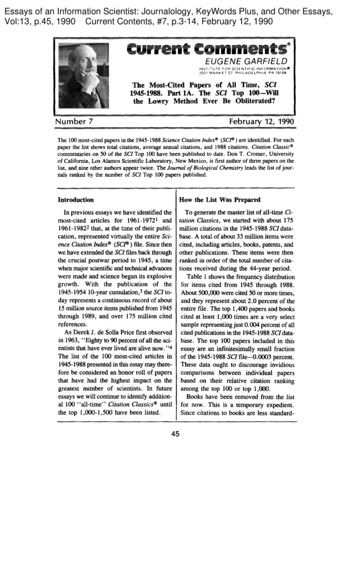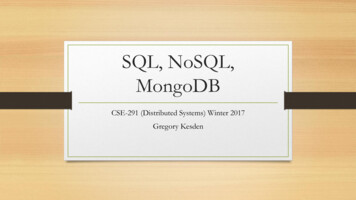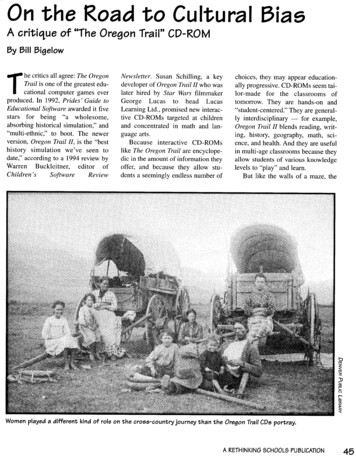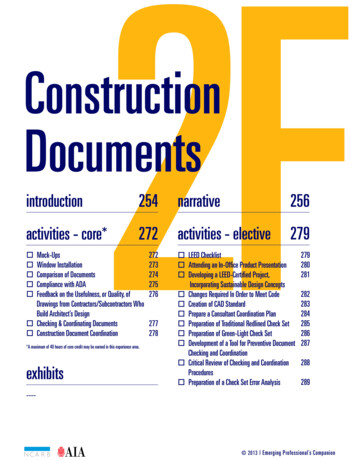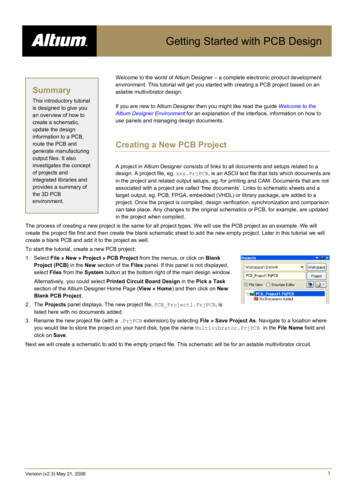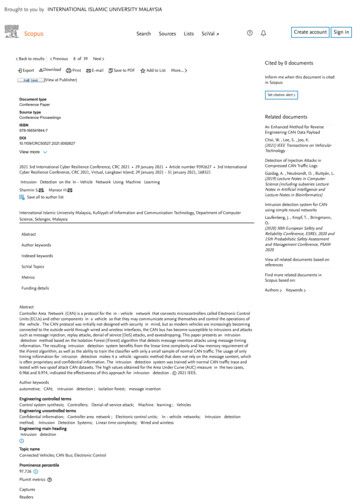
Transcription
Brought to you by INTERNATIONAL ISLAMIC UNIVERSITY MALAYSIASearch Back to results Export PreviousDownload8 of 39 PrintSourcesListsNext E-mailCreate accountSciVal Sign inCited by 0 documents Save to PDF Add to ListMore. Inform me when this document is citedin Scopus: View at Publisher Set citation alert Document typeConference PaperSource typeConference ProceedingsRelated documentsISBN978-166541844-7An Enhanced Method for ReverseEngineering CAN Data PayloadDOI10.1109/CRC50527.2021.9392627Choi, W. , Lee, S. , Joo, K.(2021) IEEE Transactions on VehicularTechnologyView more2021 3rd International Cyber Resilience Conference, CRC 2021 29 January 2021 Article number 9392627 3rd InternationalCyber Resilience Conference, CRC 2021, Virtual, Langkawi Island, 29 January 2021 - 31 January 2021, 168321Intrusion Detection on the In - Vehicle Network Using Machine LearningSharmin S.,Mansor H.Save all to author listInternational Islamic University Malaysia, Kulliyyah of Information and Communication Technology, Department of ComputerScience, Selangor, MalaysiaAbstractAuthor keywordsIndexed keywordsDetection of Injection Attacks inCompressed CAN Traffic LogsGazdag, A. , Neubrandt, D. , Buttyán, L.(2019) Lecture Notes in ComputerScience (including subseries LectureNotes in Artificial Intelligence andLecture Notes in Bioinformatics)Intrusion detection system for CANusing simple neural networksLaufenberg, J. , Kropf, T. , Bringmann,O.(2020) 30th European Safety andReliability Conference, ESREL 2020 and15th Probabilistic Safety Assessmentand Management Conference, PSAM2020View all related documents based onreferencesSciVal TopicsMetricsFind more related documents inScopus based on:Funding detailsAuthors AbstractController Area Network (CAN) is a protocol for the in - vehicle network that connects microcontrollers called Electronic ControlUnits (ECUs) and other components in a vehicle so that they may communicate among themselves and control the operations ofthe vehicle . The CAN protocol was initially not designed with security in mind, but as modern vehicles are increasingly becomingconnected to the outside world through wired and wireless interfaces, the CAN bus has become susceptible to intrusions and attackssuch as message injection, replay attacks, denial of service (DoS) attacks, and eavesdropping. This paper presents an intrusiondetection method based on the Isolation Forest (iForest) algorithm that detects message insertion attacks using message timinginformation. The resulting intrusion detection system benefits from the linear time complexity and low memory requirement ofthe iForest algorithm, as well as the ability to train the classifier with only a small sample of normal CAN traffic. The usage of onlytiming information for intrusion detection makes it a vehicle -agnostic method that does not rely on the message content, whichis often proprietary and confidential information. The intrusion detection system was trained with normal CAN traffic trace andtested with two spoof attack CAN datasets. The high values obtained for the Area Under Curve (AUC) measure in the two cases,0.966 and 0.974, indicated the effectiveness of this approach for intrusion detection . 2021 IEEE.Author keywordsautomotive; CAN;intrusion detection ; isolation forest; message insertionEngineering controlled termsControl system synthesis; Controllers; Denial-of-service attack; Machine learning ; VehiclesEngineering uncontrolled termsConfidential information; Controller area network ; Electronic control units; In - vehicle networks;method; Intrusion Detection Systems; Linear time complexity; Wired and wirelessEngineering main headingIntrusion detectionTopic nameConnected Vehicles; CAN Bus; Electronic ControlProminence percentile97.726PlumX metricsCapturesReadersIntrusion detectionKeywords
View PlumX detailsFunding sponsorFunding numberMinistry of Higher Education, MalaysiaRACER19-006-0006AcronymMOHESee opportunities by MOHEFunding textACKNOWLEDGMENT The work presented in this paper is supported by the Fundamental Research Grant Scheme for ResearchAcculturation of Early Career Researchers (FRGS-RACER) from the Ministry of Education Malaysia, no. RACER19-006-0006.View in search results format References (23)All1Export Print E-mail Save to PDFCreate bibliographyYoung, C., Zambreno, J., Olufowobi, H., Bloom, G.Survey of automotive controller area network intrusion detectionsystems (Open Access)(2019) IEEE Design and Test, 36 (6), art. no. 8640808, pp. 48-55. Cited 17 /xpl/RecentIssue.jsp?punumber 6221038doi: 10.1109/MDAT.2019.2899062View at Publisher2Koscher, K., Czeskis, A., Roesner, F., Patel, S., Kohno, T., Checkoway, S., McCoy,D., (.), Savage, S.Experimental security analysis of a modern automobile (Open Access)(2010) Proceedings - IEEE Symposium on Security and Privacy, art. no. 5504804, pp. 447462. Cited 1014 times.ISBN: 978-076954035-1doi: 10.1109/SP.2010.34View at Publisher3Checkoway, S., McCoy, D., Kantor, B., Anderson, D., Shacham, H., Savage, S., Koscher,K., (.), Kohno, T.Comprehensive experimental analyses of automotive attack surfaces(2011) Proceedings of the 20th USENIX Security Symposium, pp. 77-92. Cited 802 times.ISBN: 978-193197187-44Miller, C., Valasek, C.Remote exploitation of an unaltered passenger vehicle(2015) White Pap. Black Hat Us Conf. Cited 496 times.5Miller, C., Valasek, C.Adventures in automotive networks and control units(2013) Def Con 21, p. 99. Cited 259 times.6Bozdal, M., Samie, M., Jennions, I.A Survey on CAN Bus Protocol: Attacks, Challenges, and PotentialSolutions (Open Access)(2019) Proceedings - 2018 International Conference on Computing, Electronics andCommunications Engineering, iCCECE 2018, art. no. 8658720, pp. 201-205. Cited my/xpl/mostRecentIssue.jsp?punumber 8649565ISBN: 978-153864904-6doi: 10.1109/iCCECOME.2018.8658720View at Publisher7Avatefipour, O., Malik, H.(2018) State-of-the-Art Survey on In-Vehicle Network Communication (CAN-Bus) Securityand Vulnerabilities. Cited 26 times.
8Tomlinson, A., Bryans, J., Shaikh, S.A.Towards viable intrusion detection methods for the automotive controller area network(2018) Proc. 2nd Acm Comput. Sci. Cars Symp., pp. 1-9. Cited 13 times.9Mansor, H., Markantonakis, K., Akram, R.N., Mayes, K., Gurulian, I.Log your car: The non-invasive vehicle forensics(2016) Proceedings - 15th IEEE International Conference on Trust, Security and Privacy inComputing and Communications, 10th IEEE International Conference on Big DataScience and Engineering and 14th IEEE International Symposium on Parallel andDistributed Processing with Applications, IEEE TrustCom/BigDataSE/ISPA 2016, art. no.7847047, pp. 974-982. Cited 17 times.ISBN: 978-150903205-1doi: 10.1109/TrustCom.2016.0164View at Publisher10Marchetti, M., Stabili, D.READ: Reverse engineering of automotive data frames(2019) IEEE Transactions on Information Forensics and Security, 14 (4), art. no.8466914, pp. 1083-1097. Cited 26 /0705 02.html#5doi: 10.1109/TIFS.2018.2870826View at Publisher11Gmiden, M., Gmiden, M.H., Trabelsi, H.An intrusion detection method for securing in-vehicle CAN bus(2016) 2016 17th International Conference on Sciences and Techniques of AutomaticControl and Computer Engineering, STA 2016 - Proceedings, art. no. 7952095, pp. 176180. Cited 31 times.ISBN: 978-150903407-9doi: 10.1109/STA.2016.7952095View at Publisher12Moore, M.R., Bridges, R.A., Combs, F.L., Starr, M.S., Prowell, S.J.Modeling inter-signal arrival times for accurate detection of CAN bussignal injection attacks: A data-driven approach to in-vehicle intrusiondetection (Open Access)(2017) ACM International Conference Proceeding Series, art. no. a11. Cited 42 : 978-145034855-3doi: 10.1145/3064814.3064816View at Publisher13Song, H.M., Kim, H.R., Kim, H.K.Intrusion detection system based on the analysis of time intervals ofCAN messages for in-vehicle network(2016) International Conference on Information Networking, 2016-March, art. no.7427089, pp. 63-68. Cited 175 times.http://www.icoin.org/ISBN: 978-150901724-9doi: 10.1109/ICOIN.2016.7427089View at Publisher14Olufowobi, H., Ezeobi, U., Muhati, E., Robinson, G., Young, C., Zambreno, J., Bloom, G.Anomaly Detection Approach Using Adaptive Cumulative SumAlgorithm for Controller Area Network (Open Access)(2019) AutoSec 2019 - Proceedings of the ACM Workshop on Automotive Cybersecurity,co-located with CODASPY 2019, pp. 25-30. Cited 6 .cfm?id 3309171ISBN: 978-145036180-4doi: 10.1145/3309171.3309178View at Publisher
15Marchetti, M., Stabili, D.Anomaly detection of CAN bus messages through analysis of IDsequences (Open Access)(2017) IEEE Intelligent Vehicles Symposium, Proceedings, art. no. 7995934, pp. 15771583. Cited 74 times.ISBN: 978-150904804-5doi: 10.1109/IVS.2017.7995934View at Publisher16Tomlinson, A., Bryans, J., Shaikh, S.A.Using a one-class compound classifier to detect in-vehicle networkattacks(2018) GECCO 2018 Companion - Proceedings of the 2018 Genetic and EvolutionaryComputation Conference Companion, pp. 1926-1929. Cited 8 .cfm?id 3205651ISBN: 978-145035764-7doi: 10.1145/3205651.3208223View at Publisher17Taylor, A., Japkowicz, N., Leblanc, S.Frequency-based anomaly detection for the automotive CAN bus(2015) 2015 World Congress on Industrial Control Systems Security, WCICSS 2015, art. no.7420322, pp. 45-49. Cited 103 times.ISBN: 978-190832058-2doi: 10.1109/WCICSS.2015.7420322View at Publisher18Weber, M.Hybrid anomaly detection for automotive CAN communication(2018) Embed. Real Time Softw. Syst. ERTS2. Cited 13 times.19Avatefipour, O., Saad Al-Sumaiti, A., El-Sherbeeny, A.M., Mahrous Awwad, E., Elmeligy,M.A., Mohamed, M.A., Malik, H.An intelligent secured framework for cyberattack detection in electricvehicles' can bus using machine learning (Open Access)(2019) IEEE Access, 7, art. no. 2937576, pp. 127580-127592. Cited 29 /xpl/RecentIssue.jsp?punumber 6287639doi: 10.1109/ACCESS.2019.2937576View at Publisher20Liu, F.T., Ting, K.M., Zhou, Z.-H.Isolation forest(2008) Proceedings - IEEE International Conference on Data Mining, ICDM, art. no.4781136, pp. 413-422. Cited 1301 times.ISBN: 978-076953502-9doi: 10.1109/ICDM.2008.17View at Publisher21Seo, E., Song, H.M., Kim, H.K.GIDS: GAN based Intrusion Detection System for In-Vehicle Network(Open Access)(2018) 2018 16th Annual Conference on Privacy, Security and Trust, PST 2018, art. no.8514157. Cited 58 /xpl/mostRecentIssue.jsp?punumber 8498146ISBN: 978-153867493-2doi: 10.1109/PST.2018.8514157View at Publisher22Cortes, D.(2020) Isotree: Isolation-Based Outlier Detection.
23Ding, Z., Fei, M.An anomaly detection approach based on isolation forest algorithm forstreaming data using sliding window(2013) IFAC Proceedings Volumes (IFAC-PapersOnline), 3 (PART 1), pp. 12-17. Cited rowse cISBN: 978-390282345-8doi: 10.3182/20130902-3-CN-3020.00044View at Publisher Copyright 2021 Elsevier B.V., All rights reserved. Back to results Previous8 of 39Next Top of pageAbout ScopusLanguageCustomer ServiceWhat is Scopus日本語に切り替えるHelpContent coverage切换到简体中文Contact usScopus blog切換到繁體中文Scopus APIРусский языкPrivacy mattersTerms and conditions Privacy policy Copyright Elsevier B.V . All rights reserved. Scopus is a registered trademark of Elsevier B.V.We use cookies to help provide and enhance our service and tailor content. By continuing, you agree to the use of cookies.
Conference Paper Source type Conference Proceedings ISBN--DOI./CRC. View more 2021 3rd International Cyber Resilience Conference, CRC 2021 29 January 2021 Article number 9392627 3rd International Cyber Resilience Conference, CRC 2021, Virtual, Langkawi Island, 29 January 2021 - 31 January 2021, 168321


